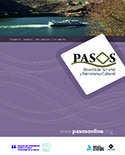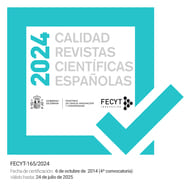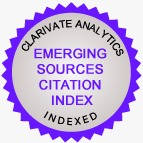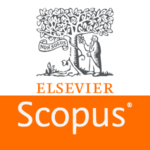Experiência e satisfação do museu: papel moderador da frequência de visitas no museu nacional de gana
DOI:
https://doi.org/10.25145/j.pasos.2021.19.016Palavras-chave:
museu, experiência, satisfação, lealdade, turismo, GanaResumo
Esta investigação visa investigar como a experiência turística suscita satisfação e contribui para a lealdade e vontade de pagar mais por um destino museológico. Mais especificamente, investiga também o papel moderador significativo da frequência de visitas na relação entre a satisfação e a vontade de pagar mais. Os museus oferecem colecções únicas para a educação e o lazer dos turistas, ao mesmo tempo que proporcionam uma melhor compreensão da diversidade transcultural das sociedades. A investigação foi realizada com 285 turistas que visitaram o Museu Nacional do Gana, com questões relacionadas com experiência, satisfação, lealdade e vontade de pagar mais. A modelação da equação estrutural foi utilizada para testar os efeitos da experiência museológica, satisfação e lealdade na vontade de pagar mais. As respostas do questionário do Museu Nacional do Gana foram analisadas e os resultados do estudo sugerem os efeitos significativos da experiência turística na satisfação, bem como os efeitos significativos da satisfação na lealdade e na vontade de pagar mais. Além disso, foi relatado o efeito moderador significativo da frequência das visitas na relação entre a satisfação e a vontade do turista de pagar mais. Neste sentido, os gestores devem desenvolver estratégias de marketing que promovam o turismo de museu na experiência de viagem e garantam uma maior satisfação no local.
Downloads
##plugins.generic.pfl.publicationFactsTitle##
##plugins.generic.pfl.reviewerProfiles## Indisp.
##plugins.generic.pfl.authorStatements##
##plugins.generic.pfl.indexedIn##
-
##plugins.generic.pfl.indexedList##
- ##plugins.generic.pfl.academicSociety##
- PASOS. Revista de Turismo y Patrimonio Cultural
- ##plugins.generic.pfl.publisher##
- Instituto Universitario de Investigación Social y Turismo. Universidad de La Laguna (España) - Instituto Universitario da Maia ISMAI (Portugal)
Referências
Aguinis, H., Edwards, J., & Bradley, K. (2016). Improving Our Understanding of Moderation and Mediation in Strategic Management Research. Organizational Research Methods, 20(4), 665-685.
Agyeman, A. (2018). Forecast: Trends and Opportunities that will Shape Africa’s Travel and Tourism in 2019. Accra: Ghana Tourism Authority. Retrieved from http://voyagesafriq.com/2018/12/31/forecast-trends-and-opportunities-that-will-shape-africas-travel-and-tourism-in-2019
Akamavi, R., Mohamed, E., Pellmann, K., & Xu, Y. (2015). Key determinants of passanger loyalty in the low-cost airline business. Tourism Management, 46(0), 528-545.
Anwar, S., & Sohail, M. (2004). Festival tourism in the United Arab Emirates: first-time versus repeat visitor perceptions. Journal of Vacation Marketing, 10(2), 161-170.
Ashie, L. (2012, january 23). museums in Ghana-Great tourist destination. Travel and Tourism. Retrieved from Travel & Tourism. https://www.modernghana.com/news/373779/museums-in-ghana-a-great-tourist-destination.html
Bagozzi, R., & Yi, Y. (2012). Specification, evaluation and interpretation of structural equation models. Journal of Academic Marketing Science, 40(1), 8-34.
Bernhadt, K., & Eroglu, S. (2004). Marketing plan for Ghana’s international tourism, GSU–TCDI project. Atlanta: Georgia State University.
Bollen, K. (1989). A new incremental fit index for general structural equation models. Sociological Methods and Research, 17(3), 303-316.
Brida, J., Meleddu, M., & Pulina, M. (2016). Understanding museum visitors’ experience: a comparative study. Journal of Cultural Heritage Management and Sustainable Development, 6(1), 47-71.
Brown, T. (2006). Confirmatory Factor Analysis for Applied Research (1st ed.). New York: The Guilford Press.
Bryne, B. (2009). Structural equation modelling with AMOS: Basic concepts, application and programming (2 ed.). London: Routledge.
Caldwell, N. (2002). (Rethinking) the measurement of service quality in museums and galleries. International Journal of Non-Profit and Voluntary Sector Marketing, 7(2), 161-171.
Calinao, D., & Lin, H. (2017). The cultural tourism potential of a fashion-related exhibition-the case of AlexanderMcQueen:SavageBeauty at the Victoria and Albert Museum. Journal of heritage Tourism, 204-217.
Carmen, A., Carmen, C., & Laguna-Garcı, M. (2017). Towards a new approach of destination loyalty drivers: satisfaction, visit intensity and tourist motivations.
Chan, J. (2009). The consumption of museum service experience: benefits and value of museum experience. Journal of Hospitality Marketing Management, 18(2-3), 173-196.
Chiappa, G., Andreu, L., & Gallarza, M. G. (2014). Emotions and visitors' satisfaction at a museum. International Journal of Culture, Tourism and Hospitality Research, 8(4), 420-431.
Chin, W. (2010). How to write up and report PLS analyses. In Handbook of partial least squares. doi:10.1007/978‐3‐540‐32827‐8_29
Chin, W., Marcolin, B., & Newsted, P. (2003). A partial least square latent variable modeling approach for measuring interaction effects: results from Monte Carlo simulation study and an electronic-mail emotion/adoption study. Information System Research, 14(2), 189-217.
Cohen, J. (1988). Statistical power analysis for the behavioral sciences (2nd ed.). NJ: Hillsdale Erlbaum.
Creswell, J. (2014). Research design: Qualitative, quantitative and mixed methods approaches (4th ed.). Los Angeles: CA: Sage.
Danaher, P., & Mattsson, J. (1994). Customer satisfaction during the service delivery process. European Journal of Marketing, 28(5), 5-16.
De Rojas, C., & Camarero, C. (2008). Visitors' experience, mood and satisfaction. Tourism Management, 3, 525-537.
Ephson, I. (2012). Ancient forts and Castles of the Gold Coast (Ghana). Accra: Ilen Publications.
Etika, I., Musa, S., & Alkassim, R. (2016). Comparison of convenience sampling and purposive sampling. American Journal of Theoretical and Applied Statistics, 5(1), 1-4.
Fornell, C., & Larcker, D. (1981). Evaluating structural equation models with unobservable variables and measurement error. Journal of Marketing Research, 18(1), 39-50.
Franklin, A. (2003). Tourism: An introduction. London: Sage.
Gabbott, M., & Hogg, G. (1998). Consumers and services. Chichester: Wiley.
Ghana Museum and Monuments Board. (2017). Ghana Museum and Monuments Board. Retrieved August 11, 2019, from National Museum in Accra : https://www.ghanamuseums.org/national-museum.php
Ghana Tourism Authority. (2020, June 06). The Year of Return Ghana 2019. Retrieved from Ghana Tourism Authority: www.yearofreturn.com
Gheorghilaș, A., Dumbrăveanu, D., Tudoricu, D., & Crăciun, A. (2017). The challenges of the 21st century museum: dealing with sophisticated visitors in a sophisticated world. International Journal of Scientific Management and Tourism, 3-4, 61-73.
Gravari-Barbas, & Maria Jacquot, S. (2017). No conflict? Discourses and management of tourism-related tensions in Paris”, in Colomb, C. and Novy, J. (Eds), Protest and Resistance in the Tourist City. Routledge Taylor and Francis Group.
Hair, J., Black, B., Babin , B., Anderson, R., & Tatham, R. (2010). Multivariate Data Analysis. London: London Prentice Hall.
Halilovic, S., & Cicic, M. (2013). Antecedents of information systems user behaviour – extended expectation-confirmation model. Behavioural & Information Technology, 32(4), 359-370.
Harrison, P., & Shaw, R. (2004). Consumer satisfaction and post-purchase intentions: An exploratory study of museum visitors. International Journal of Arts Management, 6(2), 23-32.
Hatcher, L. (1994). Step-By-Step approach: To using the SAS System for Factor Analysis. Cary, NC: SAS Institute.
Heppner, P., Wampold, B., & Kilvlighan Jr, D. (2008). Research Design in Counseling (3rd ed.). NY: Thompson Learning.
Hosany, S., & Witham, M. (2010). Dimensions of cruisers' experiences, satisfaction,and intention to recommend. Journal of Travel Research, 49(3), 351-364.
Hwang, J., & Lyu, S. (2015). The antecedents and consequences of well-being perception: An application of the experience economy to golf tournament tourists. Journal of Destination Marketing & Management, 4, 248-257.
ICOM. (2007). (International Council of Museums. Retrieved June 16, 2109, from Museum Definition. 21st General Conference in Vienna, Austria: http://icom.museum/the-vision/museumdefinition/definition
International Council of Museums (ICOM). (2010). ICOM Museums. Retrieved from http://icom.museum/
Islam, M. S. (2015). Study on Factors Influencing Tourism: Way Forward for Sustainable Tourism in Bangladesh . Journal of Tourism, Hospitality and Sports , 6, 1-14.
Jeju Tourism Organisation. (2012, December 12). African Art Museum – Africa seen from Jeju. Travel information and stories from Jeju Island, South Korea. Retrieved from https://jejutourism.wordpress.com/2012/12/02/african-art-museum-africa-seen-from-jeju/
Jöreskog, K., & Sörbom, D. (1993). LISREL 8: Structural Equation Modeling with the SIMPLIS Command Language. Chicago IL: Scientific Software International.
Kang, J., Jang, J., & Jeong, C. (2017). Understanding museum visitor satisfaction and revisit intentions through mobile guide system: moderating role of age in museum mobile guide adoption. Asia Pacific Journal of Tourism Research, 23(2), 95-105.
Kim, K., & Park. (2013). The effects of tourism ritualisation, ritual performance on tourism. Journal of Quality Assurance in Hospitality and Tourism, 14(3), 245-263.
Kim, M., & Thapa, B. (2018). The influence of self-congruity,and satisfaction on destination loyalty:a case study of the Korean DMZ,. Journal of Heritage Tourism, 13(3), 224-236,.
Koen, K., & Postma, A. (2017). Understanding and Measuring Visitor Pressure in Urban Tourism. A Study Into the Nature and Methods Used to Manage Visitor Pressure in six Major European Cities, Centre of Expertise in Leisure, Tourism and Hospitality (CELTH),. Breda and Leeuwarden and Vlissingen.
Kozak, M., Huan, T., & Beaman, J. (2002). A systematic approach to non-repeat and repeat travel. Journal of Travel and Tourism Marketing, 12(4), 19-38.
Lang, C., & Reeve, J. (2016). The responsive museum: working with audience in the 21st Century. (1st, Ed.) London: Routledge.
Lau, A., & McKercher, B. (2004). Exploration versus acquisition: A comparison of first-time and repeat visitors. Journal of Travel Research, 42(3), 279-285.
Le Gall-Ely, M. (2009). Definition, measurement and determinants of the consumer’s willingness to pay: a critical synthesis and directions for further research. Recherche and Applications in Marketing, 24(2), 91-113.
Li, X., Cheng, C., Kim, H., & Petrick, J. (2008). A systematic comparison of first time and repeat visitors via a two-phase online survey. Tourism Management, 29(2), 278-293.
Liang, R., & Zhang, J.-S. (2011). The effect of service interaction orientation on customer satisfaction and behavioral intention: The moderating effect of dining frequency. 7th International Strategic management Conference .
Lin, Y. (2017). The willingness of heritage tourist to pay for perceived authenticity in Pingxi, Taiwan. Current Issues in Tourism, 20(10), 1044-1069.
Lopez, M., Virto, N., Manzano, J., & Garcia-Madariaga, J. (2019). Archaeological tourism: looking for visitor loyalty drivers. Journal of Heritage Tourism. doi:10.1080/1743873X.2019.1602628
Mahdzar, M., Bahrin, S., Razak, I., & Ghani, A. (2017). Effects of Visitors Experience on Satisfaction and Intentions to Recommend in Malaysian Museum. World Applied Sciences Journal, 35, 59-64.
Martin-Ruiz, D., Castellanos-Verdugo, M., & Oviedo-Garcia, M. (2010). A visitors' evaluation index for visit to an archeological site. Tourism Management, 31(5), 590-596.
Mckercher, B., & Wong, D. (2004). Understanding tourism behavior: Examining the combined effects of prior visitation history and destination status. Journal of Travel Research, 43(2), 171-179.
Mehmetoglu, M., & Engen, M. (2011). Pine and Gilmore's concept of experience economy and its dimensions: An empirical examination in tourism. Journal of Quality Assurance in Hospitality & Tourism, 12(4), 237-255.
Mensah-Ansah, J., Martin, E., & Egan, D. (2011). Tourism Trends in Ghana: The Accommodation Sector. Tourism Analysis, 16(2), 157-168.
Miles, S. (2014). Battlefield sites as dark tourism attraction: an analysis of experience. Journal of Heritage Tourism, 9(2), 134-147.
Morrison, M., & Dowell, D. J. (2015). Sense of place and willingness to complementary concepts when evaluating contributions of cultural resources to regional communities. Regional Studies, 49(8), 1374-1386.
Mowatt, R., & Chancellor, C. (2011). Visiting death and life: Dark Tourism and Slave Castle. Annals of Tourism Research, 38(4), 1410-1434.
myjoyonline. (2018, November 12). Tourism fetched $2.2m for Ghana in 2017. Retrieved from myjoyonline.com.gh: https://www.myjoyonline.com/news/2018/September-26th/tourism-fetched-22m-for-ghana-in-2017.php
Namkung, Y., & Jang, S. (2009). The Effects of Interactional Fairness on Satisfaction and Behavioral Intentions: Non-mature Customers. International Journal of Hospitality Management, 28, 397-405.
Nunnally, J., & Bernstein, I. (1994). The assessment of reliability. Psychometric Theory, 1, 248-292.
Oh, h., Fiore, A., & Jeong, M. (2007). Measuring experience economy concepts: Tourism implications. Journal of Travel Research, 46, 119-132.
Oliver, R. (1981). Measurement and evaluation of satisfaction processes in retail settings. Journal of Retailing, 57(3), 25-48.
Oliver, R. (1997). Effects of expectation and disconfirmation on post-exposure product evaluation-an alternative interpretation. Journal of Applied Psychology, 62(4), 480.
Olsen, E. (2013, March 20). Arts: Looking for ways to groom repeat visitors. New York Times. Retrieved from https://www.nytimes.com/2013/03/21/arts/artsspecial/museums-look-for-ways-to-groom-repeat-visitors.html
Pennings, M. (2015). Art museums and the global tourist: experience centers in experiencescape. Athens Journal of Tourism, 209-222.
Petrick , J., Morais, D., & Norman, W. (2001). An examination of the determinants of entertainment vacationers’ intention to revisit. Journal of Travel Research, 40(1), 41-48.
Petrick, J., & Backman, S. (2002b). An examination of the determinants of golf travelers’ satisfaction. Journal of Travel Research, 40(3), 252-258.
Pine, B., & Gilmore, J. (1999). The experience economy: Work is theatre & every business a stage. Boston: Harvard Business Press.
Podsakoff, P., MacKenzie, S., Lee, J., & Podsakoff, N. (2003). Common method biases in behavioural research: A critical review of the literature and recommended remedies. Journal of Applied Psychology, 88(5), 879-903.
Preneger, T., Courvoisier, D., Hudelson, P., & Gayet-Ageron, A. (2014). Sample size for pre-tests of questionnaires. Quality of Life Research, 24(1), 147-151.
Radder, L., & Han, X. (2015). An Examination of the Museum Experience Based on Pine and Gilmore's Experience Economy Realms. The Journal of Applied Business Research , 31(2), 455-470.
Rowley, J. (1999). Measuring total customer experience in museums. International Journal of Contemporary Hospitality Management, 11(6), 303-308.
Ruiz-Alba, Nazarian, A., Rodriguez-Molina, M., & Andreu, L. (2019). Museum visitors heterogeneity and experience processing. International Journal of Hospitality Management, 78, 131-141.
Sarkar, M., Echambadi, R., & Harrison, J. (2001). Alliance entrepreneurship and firm market performance. Strategic Management Journal, 22(6-7), 701-711.
Schramm, K. (2004). Coming home to the motherland, pilgrimage tourism in Ghana. (J. E. Coleman, Ed.) New York: Routledge.
Shahrabani, S., & Regev, S. (2019). Willingness to pay for airline security. International Journal of Culture, Tourism and Hospitality Research, 13(2), 153-166.
Shaw, G., Agarwal, S., & Bull, P. (2000). Tourism consumption and tourist behaviour: a British perspective. Tourism Geographies, 2(3), 264-289.
Sonmez, S. (1998). Determining future travel behavior from past travel experience and perceptions of risk and safety. Journal of Travel Research, 37(2), 171-177.
Statistica. (2017). Most vsited art museums worldwide in 2017. Retrieved from https://www.statista.com/statistics/246293/art-museums-by-total-attendance-worldwide/
Su, M. L., Wall, G., & Jin, M. (2016). Tourist-community interactions in ethnic tourism: Tuva villages, Kansas Scenic Area, china. Journal of Tourism and Cultural Change, 14(1), 1-26.
Tabachnick, B., & Fidell, L. (2007). Using multivariate statistics (5th ed.). Boston New York: MA: Allyn & Bacon.
Teye, V. B., & Timothy, D. J. (2004). The varied colours of slave heritage in West Africa: White American stakeholders. Space and Culture, 7(2), 145-155.
The Worldbank. (2017). Population, total. Retrieved March 21, 2019, from https://data.worldbank.org/indicator/SP.POP.TOTL
Tohmo, T. (2017). Looking for determinants of willingness-to-pay for Sibelius Hall, lahti. Cogent Art and Humanities, 4. doi:10.1080/23311983.2017.1296343
Tourist Guide Africa. (2016, December 25). Explore sub-Saharan Africa's oldest museum. Tourist Guide Africa. Retrieved from https://tourismguideafrica.com/explore-sub-saharan-africas-oldest-museum/
traveltips to Ghana. (2018, April 16). The best time to travel to Ghana. Retrieved October 15, 2019, from USA Today Travel Tips: https://traveltips.usatoday.com/time-travel-ghana-18251.html#main
Trinh, T., & Ryan, C. (2016). Heritage and Cultural tourism: the role of the eesthetic when visiting My Son Cham Museum, Vietnam. Current Issues in Tourism, 19(6), 564-589.
Vu, H., Luo, J., Ye, B., Li, G., & Law, R. (2018). Evaluating museum visitors' experiences based on user-generated travel photos. Journal of Travel and Tourism Marketing, 35(4), 493-506.
Walter, A., Auer, M., & Ritter, T. (2006). The impact of network capabilities and entrepreneurial orientation on university spin-off performance. Journal of Business Venturing, 21(4), 541-567.
World Tourism Organisation. (2015). Affiliate members regional reports, volume four-tourism in Africa: tool for development. Retrieved from http://cf.cdn.unwto.org/sites/all/files/pdf/tourism_africa_tool_development1.compressed_0_0.pdf
World Travel and Tourism Centre. (2018). Economic impact research report. WTTC. Retrieved from https://www.wttc.org/-/media/files/reports/economic-impact-research/countries-2018/ghana2018.pdf
Yankholmes, A., & McKercher, B. (2015). Understanding visitors to slavery heritage sites in Ghana. Tourism Management, 51, 22-32.
Zeithaml, V., Berry, L., & Parasuraman, A. (1996). The behavioural consequences of service quality. Journal of Marketing, 60(2), 31-46.
Downloads
Publicado
Como Citar
Edição
Seção
Licença
Copyright (c) 2020 alexander Kofi Preko, Theophilus Francis Gyepi-Garbrah

Este trabalho está licenciado sob uma licença Creative Commons Attribution-NonCommercial-NoDerivatives 4.0 International License.
Confirmo que o trabalho é original (de minha/nossa autoria), e que não será submetido a outras revistas ou publicações até a resolução final do processo de revisão em PASOS, RTPC.
Autorizo a publicação do meu trabalho por PASOS, PSTN de acesso livre e aberto em qualquer dos formatos que considere oportuno, por tempo indeterminado e como colaboração não remunerada.
Da mesma forma, o(s) autor(es) entende(m) que o trabalho publicado pode ser vinculado ou depositado em qualquer servidor ou incluído em outras publicações (republicação), desde que o novo local e/ou a nova edição façam referência à publicação original e reconheçam a autoria e propriedade de direitos autorais das publicações PASOS RTPC.
Os autores entendem que uma verificação de plágio autoplágio será realizada, e o artigo poderá ser removido a qualquer momento do fluxo editorial.










